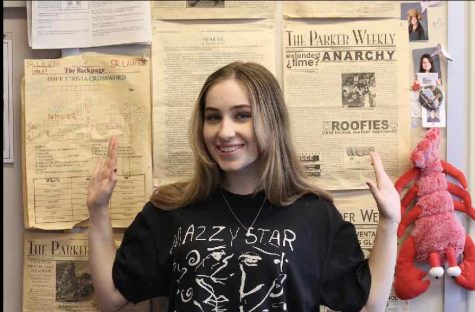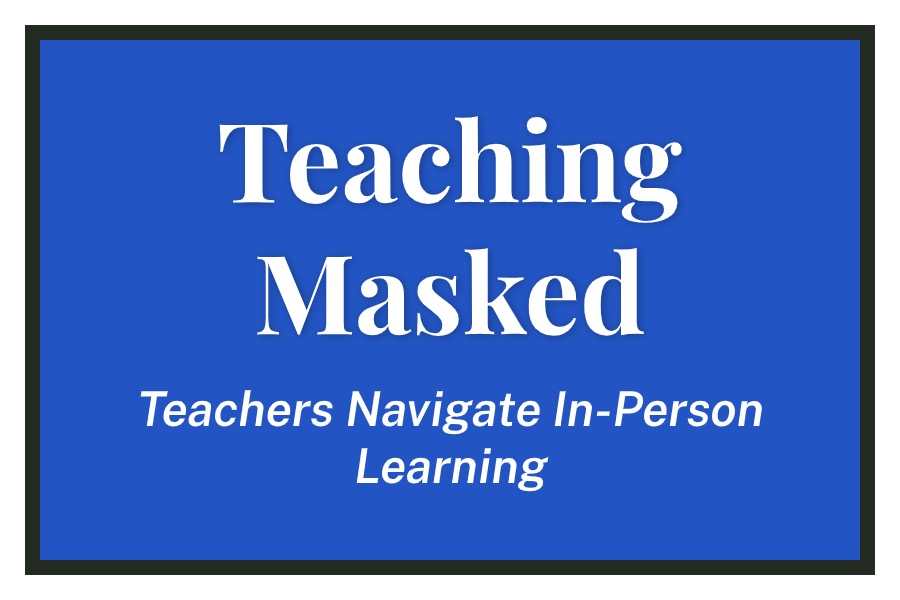Teaching Masked
Teachers Navigate In-Person Learning
Learning through a screen is difficult for many in the Upper School, but teaching through a mask presents its own set of challenges.
Though the Upper School remains remote, teachers in the Lower, Intermediate, and Middle Schools are primarily working on campus, teaching to different pods made up of both in-person and online learners. Beyond navigating new safety protocols, teachers have to adjust to new fears and new student dynamics.
Teachers manage many different safety protocols meant to protect both themselves and the students, and they need to enforce six feet of physical distance, mask-wearing, and the assigned seats for members of each pod.
They’re also adjusting to non-traditional learning spaces, such as the library, the cat boxes, and the gym, which are acting as classrooms. Additional assistant teachers hired during the pandemic are able to help monitor students in these spaces.
The school purchased around 20,000 masks at the beginning of the school year to distribute to teachers, and purchased additional face shields upon request. Hand sanitizer, alcohol wipes, and other sanitization products are also provided.
Head of Intermediate and Middle Schools John Novick noted that some teachers stay farther from the students and closer to the front of the room, both for safety reasons and to better accommodate students who are tuned in via Zoom. “It’s very un-Parker-like, but when your health is at stake, you compromise things,” Novick said.
Despite safety precautions, Novick noted that many teachers were still afraid. “Coming to school during a pandemic and working with children every day is scary and anybody who tells you otherwise is lying to you,” Novick said.
“Most of my fears around in-person teaching are what others fear — that we’ll have a coronavirus outbreak that impacts our community and the greater Chicago community,” eighth grade history teacher Stephanie Nishimoto-Lorenzo said via email.
Though there have been no on-campus COVID-19 transmission at the time of writing, there have been cases of the coronavirus that have required certain pods and teachers to learn and teach remotely. “The most challenging part about the switch to remote is that it required me to quarantine from my family,” Lorenzo said.
Upper School Mathematics Teacher Victoria Lee, who is also the head of the Faculty Association, said the administration was responsive to requests for resources such as more Personal Protective Equipment (PPE) or extra assistant teachers. “You think you have everything, until that first day when all the kids show up,” Lee said.
Novick oversees teachers with a range of reactions to the in-person system. “There’s clearly that element of the faculty that is relieved and grateful,” Novick said. “As exhausting as it is with all the health and safety protocols, they’re happy to be here.”
“On the other hand, there are also faculty who really are finding in person schooling overwhelming,” Novick added. “They find the masking and the physical distancing and the podding, the limited movement for children and the compressed school day, to be a hindrance to connection.”
Novick tries to take feedback from teachers who are having a more negative experience. “They often raise questions that make us examine our administrative practice,” Novick said. “It’s a good, healthy thing for us to do.”
Feedback to the administration is also provided via the Parker Teachers Union, who makes sure that the administration adheres to the verbiage of their Collective Bargaining Agreement (CBA). During the pandemic, the union is particularly monitoring the number of contact minutes with students that teachers have to make sure it’s not in violation of the CBA.
Contact minutes are not currently above the limit, as the school day has been shortened by one hour, but the nature of the work teachers do during the day has shifted and increased.
Through the Human Resources department, faculty can submit confidential medical information that qualifies them to work remotely under employment law. Currently, there are around half a dozen teachers in the Intermediate and Middle School instructing their classes via Zoom, with assistant teachers in the room for supervision of in-person students.
The school has also stated that teachers would not be penalized for contracting the coronavirus. “That was a big concern by teachers,” Lee said. “‘What if I run out of my personal days? And what if I run out of my sick days? And what if I have to quarantine and then I can’t teach?”
Before Head of the Upper School Justin Brandon’s announcement that the Upper School would remain remote through January, Lee noted that many in-person teachers were nervous about a potential return of high schoolers. “They’re getting to be this fine-tuned machine, where they kind of move together in tandem,” Lee said. “If the Upper School was to come back, that would upset this rhythm and it’s taken them a while to get used to.”
Union leadership, Principal Dan Frank and Director of Human Resources Laureen Sweers have started meeting every over week during the pandemic, up from once a month, to address concerns like that one and to communicate with the administration about the needs of teachers.
Though she noted that sometimes these meetings can get tense or uncomfortable, Lee values them, especially as non-union schools negotiate the terms of hybrid returns. “It makes me nervous for a lot of my friends who are at non-union schools,” Lee said. “Everyone as an individual would have to confront or have a conversation with their principal and that’s hard to do. Here it’s nice that we have a collective voice.”
The union itself also meets more frequently during the pandemic, to give extra time to get through the agenda and to provide space for teacher’s to vent. Faculty meetings have been shortened in length to give teachers more time to decompress or to attend to childcare needs that have changed during the pandemic.
Even with systems in place for teachers to request support, Novick still worries about the emotional toll the pandemic is taking on teachers. “They’re being asked to adapt their practice to a very strict, stringent protocol,” Novick said. “We feel bad about it, even when we’re reaching kids and changing them for the better. We still walk away feeling less than, because we’re not measuring up to who we were before the pandemic.”








